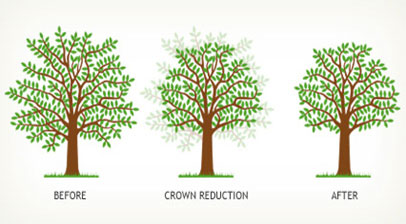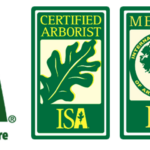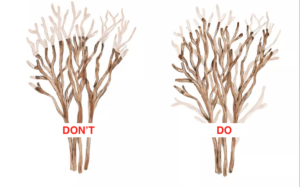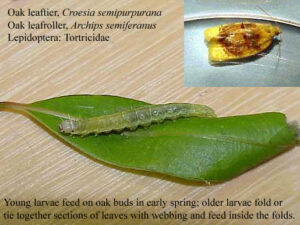Crown Reduction & Canopy Raising: Enhancing Tree Health and Safety
Caring for trees involves various pruning techniques to maintain their health and appearance. Two important methods are crown reduction and canopy raising. These approaches, executed by skilled arborists, contribute to controlled growth, risk reduction, and the beauty of our surroundings.
Crown Reduction

Crown reduction is a precise pruning technique used to lessen the size and volume of a tree’s crown or canopy. By selectively removing branches and foliage from the outer edges of the crown, the tree achieves a more compact and balanced shape. Crown reduction serves several purposes:
Size Management: When a tree becomes too large for its environment, crown reduction helps control its size, preventing interference with nearby structures and power lines.
Risk Minimization: Trees with unbalanced or heavy crowns can pose risks during storms or strong winds. Crown reduction redistributes weight, enhancing structural stability and reducing the chance of branch failure or uprooting.
Sunlight Penetration: In densely shaded areas, crown reduction allows more sunlight to reach the ground, benefiting undergrowth and the overall ecosystem.
Professional arborists are essential for proper crown reduction. They evaluate tree health, structure, and specific pruning needs. It’s crucial to avoid excessive or careless branch removal, as this can harm the tree’s well-being and aesthetics.
Canopy Raising

Tree canopy raising, also called crown lifting or canopy elevation, focuses on increasing vertical space between a tree’s lower branches and the ground or nearby structures. By selectively trimming lower branches while maintaining the upper canopy, this technique serves various purposes:
Clearance: Canopy raising creates space for pedestrians, vehicles, or structures beneath the tree. It ensures unhindered passage.
Visibility: When trees obstruct sightlines at intersections or driveways, canopy raising enhances visibility, benefiting both drivers and pedestrians.
Aesthetics: Canopy raising can enhance a tree’s symmetry and appearance by refining its shape.
Access: This method aids maintenance activities like landscaping or utility installations by facilitating access.
When applying canopy raising, it’s important to consider the tree species, growth patterns, and potential impacts on health and stability. Consulting a professional arborist ensures proper pruning methods, promoting long-term tree health and structural integrity. By embracing these techniques, we contribute to healthier, safer, and more appealing environments.




